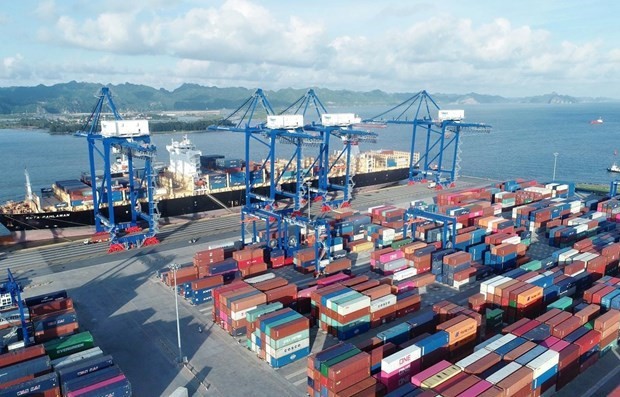 A view of the Lach Huyen container terminal in Hai Phong city (Illustrative photo: VNA)
A view of the Lach Huyen container terminal in Hai Phong city (Illustrative photo: VNA)
According to Dau tu (Vietnam Investment Review), MSC Chairman Gianluigi Aponte is scheduled to arrive in Hanoi and HCMC this week to meet leaders of the Vietnamese Government, relevant ministries and sectors, HCMC, and Vietnamese partners to discuss the Can Gio international transit terminal - an ambitious project worth about US$6 billion that the MSC and its subsidiary Terminal Investment Limited (TIL) are pursuing.
It comes within a cooperation framework on developing seaport infrastructure and logistics services that MSC/TIL signed with VIMC and its subsidiary Saigon Port JSC on November 4, 2021 in the presence of Prime Minister Pham Minh Chinh during his visit to France.
Gianluigi Aponte and CEO of MSC/TIL Ammar Kanaan were also present at that signing ceremony.
Meeting PM Chinh, they pledged to bring along the international cargo transited in regional countries to the Vietnamese terminal - a factor believed to the best guarantee for the success of the Can Gio project.
Meanwhile, the Vietnamese leader welcomed MSC/TIL’s cooperation proposal, asking the firm to boost investment in the seaport sector and increase the volume of goods transited in the country. He also said he will order relevant ministries and sectors to create the best possible conditions for MSC/TIL, VIMC and Saigon Port to carry out this project.
In a report sent to the Ministry of Transport on July 5, VIMC affirmed MSC/TIL’s high evaluation of the planned location for the terminal (on Phu Loi Islet), as well as opportunities to turn this future terminal into a major gateway for international trading in the region.
In a document recently submitted to PM Chinh, the HCMC People’s Committee proposed the leader assign the Ministry of Transport to work with the committee and relevant agencies to assess advantages, opportunities and possibility of the Can Gio project.
With about 7.2km of wharves, this project is expected to be capable of handling 10 - 15 million TEUs (twenty-foot equivalent units) of cargo and serving the world’s largest container ships (24,000 TEUs) at present.
It will be implemented in seven phases, the first of which is hoped to start in 2024 and become operational in 2027 while the last phase is set to be put into use in 2040.
According to the committee, the zoned Can Gio terminal area in the mouth of the Cai Mep River boasts favorable natural conditions for handling container vessels with deadweight tonnage (DWT) of up to 250,000 (or 24,000 TEUs), including its location on the shipping routes to Europe, Africa and the Americas. It holds conditions for developing an international transit terminal able to compete with regional countries and make a breakthrough for the maritime economy in HCMC and Vietnam as a whole.
Cargo throughput in seaports of HCMC grew by 7.34 percent during 2015 - 2020, and the rate is predicted at 5 percent during 2021 - 2025.
In 2021, the throughput stood at 164.19 million tons, accounting for 23.36 percent of the total volume recorded at seaports nationwide.
It comes within a cooperation framework on developing seaport infrastructure and logistics services that MSC/TIL signed with VIMC and its subsidiary Saigon Port JSC on November 4, 2021 in the presence of Prime Minister Pham Minh Chinh during his visit to France.
Gianluigi Aponte and CEO of MSC/TIL Ammar Kanaan were also present at that signing ceremony.
Meeting PM Chinh, they pledged to bring along the international cargo transited in regional countries to the Vietnamese terminal - a factor believed to the best guarantee for the success of the Can Gio project.
Meanwhile, the Vietnamese leader welcomed MSC/TIL’s cooperation proposal, asking the firm to boost investment in the seaport sector and increase the volume of goods transited in the country. He also said he will order relevant ministries and sectors to create the best possible conditions for MSC/TIL, VIMC and Saigon Port to carry out this project.
In a report sent to the Ministry of Transport on July 5, VIMC affirmed MSC/TIL’s high evaluation of the planned location for the terminal (on Phu Loi Islet), as well as opportunities to turn this future terminal into a major gateway for international trading in the region.
In a document recently submitted to PM Chinh, the HCMC People’s Committee proposed the leader assign the Ministry of Transport to work with the committee and relevant agencies to assess advantages, opportunities and possibility of the Can Gio project.
With about 7.2km of wharves, this project is expected to be capable of handling 10 - 15 million TEUs (twenty-foot equivalent units) of cargo and serving the world’s largest container ships (24,000 TEUs) at present.
It will be implemented in seven phases, the first of which is hoped to start in 2024 and become operational in 2027 while the last phase is set to be put into use in 2040.
According to the committee, the zoned Can Gio terminal area in the mouth of the Cai Mep River boasts favorable natural conditions for handling container vessels with deadweight tonnage (DWT) of up to 250,000 (or 24,000 TEUs), including its location on the shipping routes to Europe, Africa and the Americas. It holds conditions for developing an international transit terminal able to compete with regional countries and make a breakthrough for the maritime economy in HCMC and Vietnam as a whole.
Cargo throughput in seaports of HCMC grew by 7.34 percent during 2015 - 2020, and the rate is predicted at 5 percent during 2021 - 2025.
In 2021, the throughput stood at 164.19 million tons, accounting for 23.36 percent of the total volume recorded at seaports nationwide.
























